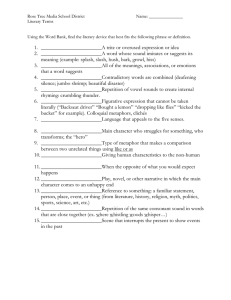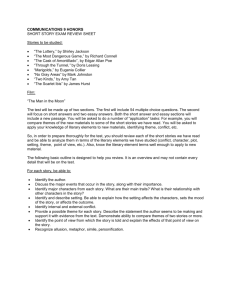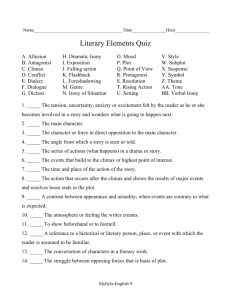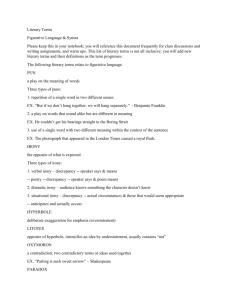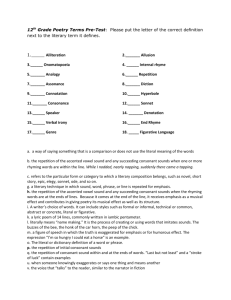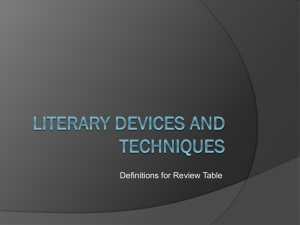LITERARY TERMS
advertisement
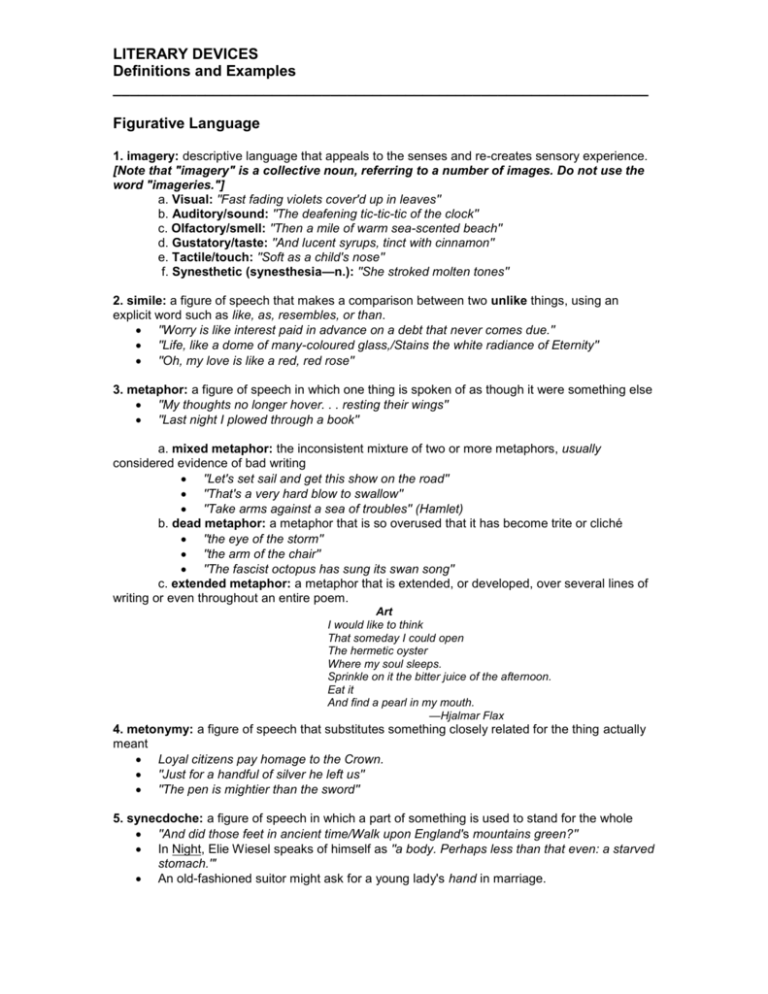
LITERARY DEVICES Definitions and Examples ________________________________________________________________ Figurative Language 1. imagery: descriptive language that appeals to the senses and re-creates sensory experience. [Note that "imagery" is a collective noun, referring to a number of images. Do not use the word "imageries."] a. Visual: "Fast fading violets cover'd up in leaves" b. Auditory/sound: "The deafening tic-tic-tic of the clock" c. Olfactory/smell: "Then a mile of warm sea-scented beach" d. Gustatory/taste: "And lucent syrups, tinct with cinnamon" e. Tactile/touch: "Soft as a child's nose" f. Synesthetic (synesthesia—n.): "She stroked molten tones" 2. simile: a figure of speech that makes a comparison between two unlike things, using an explicit word such as like, as, resembles, or than. "Worry is like interest paid in advance on a debt that never comes due." "Life, like a dome of many-coloured glass,/Stains the white radiance of Eternity" "Oh, my love is like a red, red rose" 3. metaphor: a figure of speech in which one thing is spoken of as though it were something else "My thoughts no longer hover. . . resting their wings" "Last night I plowed through a book" a. mixed metaphor: the inconsistent mixture of two or more metaphors, usually considered evidence of bad writing "Let's set sail and get this show on the road" "That's a very hard blow to swallow" "Take arms against a sea of troubles" (Hamlet) b. dead metaphor: a metaphor that is so overused that it has become trite or cliché "the eye of the storm" "the arm of the chair" "The fascist octopus has sung its swan song" c. extended metaphor: a metaphor that is extended, or developed, over several lines of writing or even throughout an entire poem. Art I would like to think That someday I could open The hermetic oyster Where my soul sleeps. Sprinkle on it the bitter juice of the afternoon. Eat it And find a pearl in my mouth. —Hjalmar Flax 4. metonymy: a figure of speech that substitutes something closely related for the thing actually meant Loyal citizens pay homage to the Crown. "Just for a handful of silver he left us" "The pen is mightier than the sword" 5. synecdoche: a figure of speech in which a part of something is used to stand for the whole "And did those feet in ancient time/Walk upon England's mountains green?" In Night, Elie Wiesel speaks of himself as "a body. Perhaps less than that even: a starved stomach."' An old-fashioned suitor might ask for a young lady's hand in marriage. 6. antithesis: a figure of speech in which contrasting or opposite ideas are presented in parallel form. "Some praise at morning what they blame at night." "I long and dread to close." "To err is human, to forgive, divine." "It was the best of times, it was the worst of time, it was the age of wisdom, it was the age of foolishness, it was the epoch of belief, it was the epoch of incredulity. . ." (the beginning of Dickens's A Tale of Two Cities) 7. hyperbole: a deliberate exaggeration or overstatement "All the perfumes of Arabia will not sweeten this little hand." "He had a zit the size of Texas!" 8. personification: a figure of speech in which a nonhuman subject is given human characteristics "a smiling moon" "a jovial sun" "Father Time" 9. apostrophe: a figure of speech in which the speaker directly and often emotionally addresses a person who is dead or otherwise not physically present, an imaginary person or entity, something inhuman, or a place or concept (usually an abstract idea or ideal) "Death, be not proud!" (Donne) "Oh, grave, where is thy victory? Oh, death, where is thy sting?" "Roll on, thou deep and dark blue ocean, roll!" 10. irony: a contrast or discrepancy between expectation and reality—between what is said and what is really meant, between what is expected to happen and what really does happen, or between what appears to be true and what is really true a. verbal irony—a writer or speaker says one thing but means another (often resembling sarcasm, which is NOT a literary device) "You're a real Babe Ruth" (said to a bad baseball player) b. situational irony—a contrast between what would seem appropriate and what really happens. Alanis Morissette in "Ironic" (1995) gives these examples: Dying the day after you win the lottery Working up the courage to take your first airplane flight and then crashing Finding the man of your dreams only to discover that he has a beautiful wife c. dramatic irony—a discrepancy between a character's perception and what the reader or audience knows to be true Romeo drinks poison because he thinks Juliet is dead, while the audience knows she is merely drugged and not dead at all. 11. rhetorical question: any question asked for a purpose other than to obtain the information the question asks Why are you so stupid? Why me, God? "Shall I compare thee to a summer's day?" 12. Imprecation: a curse This is not considered a literary device in English. A Few More Terms: oxymoron: a figure of speech that fuses two contradictory or opposing ideas "freezing fire" "happy grief" "darkness visible" allusion: a reference to a statement, person, place, event, or thing that is known from literature, history, religion, myth, politics, sports, science, or pop culture I swear it "by Cupid's bow." Plan ahead. It was not raining when Noah built the Ark. The software included a Trojan horse. as old as Mathuselah "sons of Adam and daughters of Eve" symbol: anything that stands for or represents something larger and more complex symbolism: the serious and relatively sustained use of symbols to represent or suggest other things or ideas Joseph Conrad uses snake symbolism in Heart of Darkness. Avoid the word "symbolisms," like the equally obnoxious "imageries." If tempted, consider "symbols" or "images" instead. ********************************* Sound Devices (or "prosodic devices" when analyzing poetry) alliteration: the repetition of initial consonant sounds, or simply the repetition of sounds in words "The bird's fire-fangled feathers dangle down" "The voice of the sea is seductive; never ceasing, whispering, clamoring, murmuring, inviting the soul to wander for a spell in abysses of solitude." a. assonance: the repetition of identical or similar vowel sounds "What large, dark hands are those at the window?" (Lawrence) "Thou foster child of silence and slow time" (Keats) b. consonance: the repetition of consonant sounds in stressed syllables "Let the boy try along this bayonet blade How cold steel is, and keen with hunger of blood" [Assonance and consonance often produce effects known as half-rhyme, approximate rhyme or slant rhyme.] repetition: the use, more than once, of any element of language—a sound, a word, a phrase, a clause, a sentence, a grammatical pattern, or a rhythmical pattern. "Tomorrow and tomorrow and tomorrow/Creeps in this petty pace. . ." pun: a play on words, either using a word or a phrase that has two different meanings or two different words or phrases with the same sound What has four wheels and flies? A garbage truck! The dying Mercutio: Ask for me tomorrow and you shall find me a grave man. Lumberyard: "Come see, come saw." ellipsis: three periods (or dot-dot-dot) used to show a pause in dialogue due to hesitancy, perhaps, or to show that words or sentences have been left out Why is it . . ., Ozu suddenly thought one day, that I'm always worrying about him? . . . I'm a student at P. University now, and I've got my own life to live. . . . parallelism: the use of grammatically similar constructions, often repetition, to accentuate ideas or images. See the Dickens example in antithesis. "Thomas Gradgrind, sir. A man of realities. A man of facts and calculations. A man who proceeds upon the principle that two and two are four, and nothing over, and who is not to be talked into allowing for anything over. Thomas Gradgrind, sir—peremptorily Thomas—Thomas Gradgrind." onomatopoeia: The use of words whose sounds imitate or suggest their meanings Crackle, pop, fizz, click, zoom, chirp Tic-tic-tic Thump-thump-thump "Suck was a queer word. The sound was ugly. Once he had washed his hands in the lavatory of the Wicklow Hotel and his father pulled the stopper up by the chain after and the dirty water went down through the hole in the basin. And when it had all gone down slowly the hole in the basin had made a sound like that: suck. Only louder" (Joyce). *************************** FUNDAMENTAL ELEMENTS OF THE ART OF THE NOVEL plot: the sequence of events in a literary work [Gustav Freytag, of Freytag's Pyramid fame, enumerated a typical sequence of plot events: introduction, rising action, climax, falling action and catastrophe (now often termed denouement). Some variations of plot include flashbacks and "flash forwards." Story is the raw material of which plot is constructed. According to E.M. Forster, "the king died and the queen died" is a story, whereas "the king died and then the queen died of grief" is a plot because it emphasizes causality. Hmmmm? theme: not simply the subject of a literary work, but rather a statement that the text seems to be making about that subject. So the subject of a novel might be suffering; the theme, depending on the view of the individual author, might be that suffering is in God's plan and should therefore simply be accepted. English teachers make use of many synonyms for theme: main idea, gist, central concept, message, moral, lesson or perspective (to name few). motif: a unifying element in an artistic work, especially any recurrent image, symbol, theme, character type, subject or narrative detail. (Not to be confused with motive.) Specific colors such as green and white serve as motifs in Fitzgerald's The Great Gatsby. setting: that combination of place, historical time, and social milieu that provides the general background for the characters and plot of a literary work. narrator: a speaker through whom an author presents a narrative, often but not always a character in the work point of view/perspective: the vantage point from which a narrative is told first person ("I") third person (omniscient or limited) reliable unreliable style: the way in which a literary work is written, the devices the author uses to express his or her thoughts and convey the work's subject matter syntax structure tone (voice): the attitude of the author toward the reader or the subject matter mood/atmosphere: the general feeling created in the reader by a work at a given point
